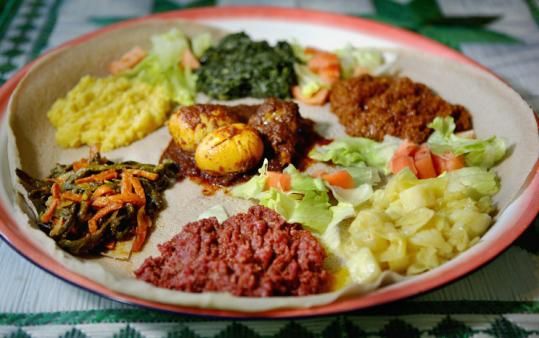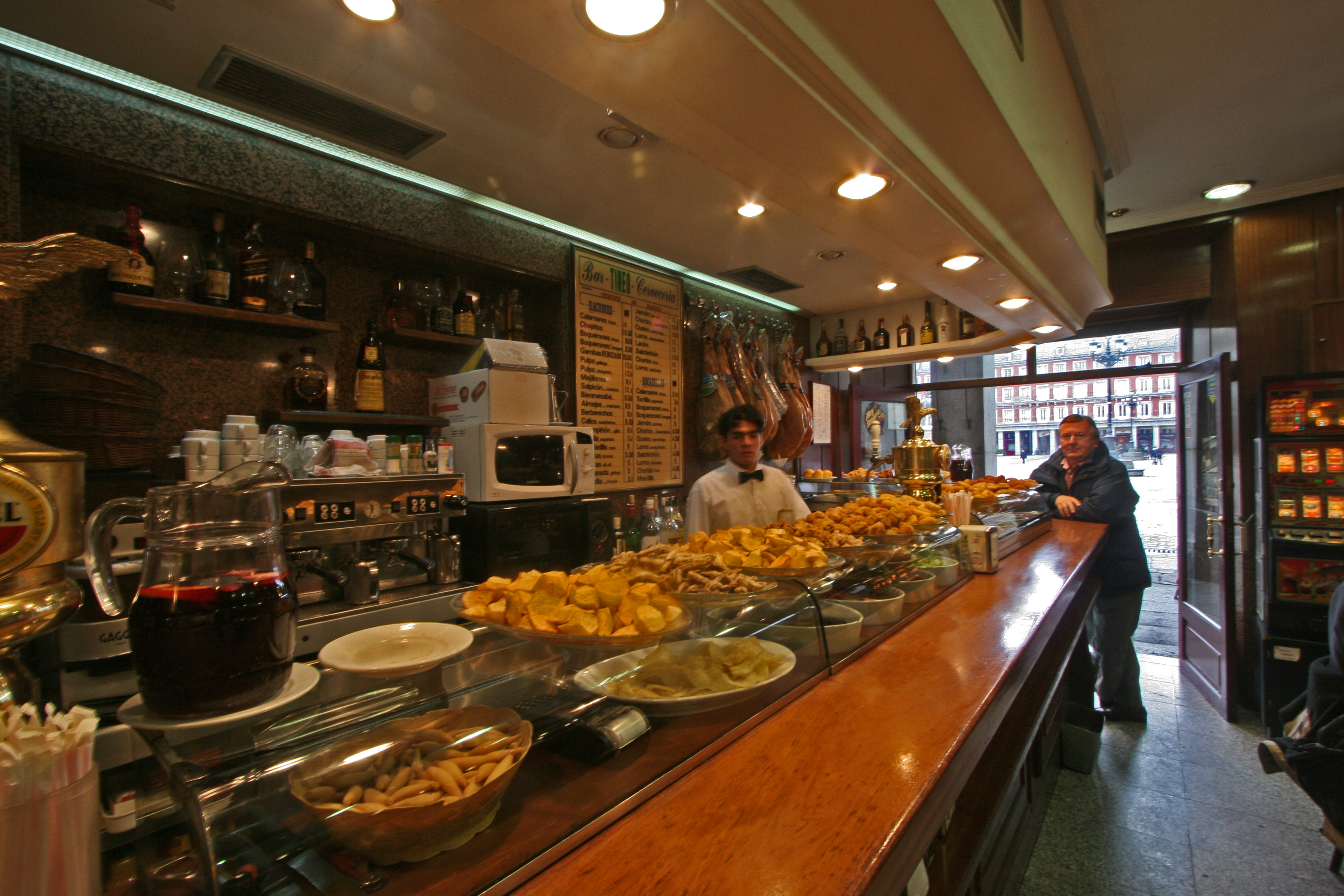|
Beyaynetu
Beyaynetu () is an Ethiopia, Ethiopian/Eritrea, Eritrean dish, often savoured as a hearty meal. It combines injera—a sourdough flatbread—with a variety of ingredients, including meat and vegetables. One of the national dishes of Ethiopia, it reflects the diverse flavours of the country's Ethiopian cuisine, cuisine. The term ''bäyaynätu'' () in Amharic can be translated as "various" or "assorted", indicating the wide range of ingredients that make up this dish. Varieties * Vegetarian: The vegetable-only style is known as ''ʾätkəlt bäyaynätu'' () or ''yetsom beyaynetu'' (). Here, ''ʾätkəlt'' refers to "plants" or "vegetables", and ''yetsom'' signifies "Fasting and abstinence in the Ethiopian Orthodox Tewahedo Church, fasting", denoting the period when members of the Ethiopian Orthodox Tewahedo Church abstain from consuming meat and dairy products for several weeks. The prefix ''yä'' functions as a genitive marker, combined with ''tsom'' ("fasting") to denote "of fa ... [...More Info...] [...Related Items...] OR: [Wikipedia] [Google] [Baidu] |
Injera
Injera (, ; ; ) is a sour fermented pancake-like flatbread with a slightly spongy texture, traditionally made of teff flour. In Ethiopia and Eritrea, injera is a staple. Injera is central to the dining process in Amhara community, like bread or rice elsewhere and is usually stored in the mesob. Ingredients Traditionally, injera is made with just two ingredients: teff flour and water. Teff flour is ground from the grains of ''Eragrostis tef'', also known as teff, a cereal crop from the Ethiopian Highlands. Teff production is limited to certain middle elevations with adequate rainfall and is a low-yield crop, so it is relatively expensive for the average farming household. Many farmers in the Ethiopian highlands grow their own subsistence grains, so wheat, barley, corn, or rice flour are sometimes used to replace the teff content. Teff seeds are graded according to color, used to make different kinds of injera: ''nech'' (white), ''key'' or ''quey'' (red), and ''sergegna ... [...More Info...] [...Related Items...] OR: [Wikipedia] [Google] [Baidu] |
Banchan
''Banchan'' ( ; ; ) are small side dishes served along with cooked rice in Korean cuisine. ''Banchan'' are often set in the middle of the table to be shared. At the center of the table is the secondary main course, such as ''galbi'' or ''bulgogi'', and a shared pot of ''jjigae''. Bowls of cooked rice and ''guk'' (soup) are set individually. ''Banchan'' are served in small portions, meant to be finished at each meal and replenished during the meal if not enough. Usually, the more formal the meals are, the more ''banchan'' there will be. Jeolla Province is particularly famous for serving many different varieties of ''banchan'' in a single meal. The basic table setting for a meal called ''bansang'' usually consists of ''bap (food), bap'' (, cooked rice), ''guk'' or ''guk, tang'' (soup), ''gochujang'' or soy sauce, ''ganjang'', ''jjigae'', and ''kimchi''. According to the number of ''banchan'' added, the table setting is called ''3 cheop'' (), ''5 cheop'' (), ''7 cheop'' (), ''9 c ... [...More Info...] [...Related Items...] OR: [Wikipedia] [Google] [Baidu] |
Thali
Thali (meaning "plate" or "tray") or Bhojanam (meaning "full meal") is a round Platter (dishware), platter used to serve food in South Asia, Southeast Asia and the Caribbean. Thali is also used to refer to an Indian-style meal made up of a selection of various dishes which are served on a platter. Puja thali, Thali is also used in south Asia for ceremonial purposes. History Early history According to archeologist Bindeshwari Prasad Sinha, dish-on-stand and simple dishes belonging to the Indus Valley Civilization may be regarded as the prototype of Indian dishes as thalis but these do not have accompanying bowls commonly seen with thalis. According to Sinha the distinctive thali accompanying bowls instead appears in the Painted Grey Ware culture. Archeologist B.B. Lal similarly suggests food was eaten from the Painted Grey Ware culture, Painted Grey Ware dishes and bowls. B.B Lal notes that "typical dinner set in the Painted Grey Ware consists of the thali (dish), katora (bow ... [...More Info...] [...Related Items...] OR: [Wikipedia] [Google] [Baidu] |
Ethiopian Cuisine
Ethiopian cuisine ( "Ye-Ītyōṗṗyā məgəb") characteristically consists of vegetable and often very spicy meat dishes. This is usually in the form of ''wat (food), wat,'' a thick stew, served on top of ''injera'' (), a large sourdough flatbread,Javins, Marie."Eating and Drinking in Ethiopia." Accessed July 2011. which is about in diameter and made out of Fermentation, fermented teff flour. People of Ethiopia, Ethiopians usually eat with their right hands, using pieces of to pick up bites of entrées and side dishes. The Fasting and abstinence in the Ethiopian Orthodox Tewahedo Church, Ethiopian Orthodox Tewahedo Church prescribes a number of fasting periods known as ''tsom'' ( ''ṣōm''), including all Wednesdays and Fridays and the whole Lenten season (including fifteen days outside Lent proper). Per Orien ... [...More Info...] [...Related Items...] OR: [Wikipedia] [Google] [Baidu] |
Fasting And Abstinence In The Ethiopian Orthodox Tewahedo Church
Fasting and abstinence ( ''ṣōm''; Amharic and Tigrinya: ''tsom'') have historically constituted a major element of the practice of the Ethiopian Orthodox Tewahedo Church, following the counsel of Saint Paul (; ''k’idus p’awilos'') to "chastise the body and bring it under subjection" per 1 Corinthians 9:27. It is generally agreed, and asserted by the Church itself, that the fasting regime of the Ethiopian Church is the strictest of any Church, with 180 mandatory fasting days for laypeople and up to 252 days for clergy and the particularly observant. The general list of fasts are laid out in the Fetha Negest. Fasting regimen During fasts, the observant are required to partake in no more than one meal a day, which is to be eaten in the afternoon or evening. Fasting involves abstention from animal products (meat, dairy, and eggs), and refraining from eating or drinking before 3:00 pm. Ethiopian devotees may also abstain from sexual activity and the consumption of alcohol ... [...More Info...] [...Related Items...] OR: [Wikipedia] [Google] [Baidu] |
Eritrean Cuisine
Eritrean cuisine is based on Eritrea's native culinary traditions, but also arises from social interchanges with other regions. The local cuisine shares very strong similarities with the cuisine of neighboring Ethiopia with several dishes being cultural to both nations as a result of the two nations having been unified for hundreds of years. It also has influences from Italian cuisine due to the Italian colonization of the nation, and minor influences from other cuisines in the region. Overview Eritrean cuisine shares similarities with surrounding countries' cuisines; however, the cuisine has its unique characteristics. The main traditional food in Eritrean cuisine is '' tsebhi'' (stew), served with '' injera'' (flatbread made from teff, wheat, or sorghum and ''hilbet'' (paste made from legumes; mainly lentil and faba beans). A typical traditional Eritrean dish consists of ''injera'' accompanied by a spicy stew, which frequently includes beef, goat, lamb or fish. Overal ... [...More Info...] [...Related Items...] OR: [Wikipedia] [Google] [Baidu] |
Tapas
Tapas () are appetisers or snacks in Spanish cuisine. They can be combined to make a full meal and are served cold (such as mixed olives and cheese) or hot (such as , which are battered, fried baby squid; or , spicy potatoes). In some bars and restaurants in Spain and across the globe, tapas have evolved into a sophisticated cuisine. In some Central American countries, such snacks are known as . In parts of Mexico, similar dishes are called ''botanas''. An individual appetizer (or single order of an item) is a . History The word "''tapas''", a plural, is derived from the Spanish verb ''tapar'', "to cover", a cognate of the English "top". Multiple theories for the term's use for appetizers exist. One theory holds that in pre-19th-century Spain few innkeepers at ''posadas'', '' albergues'' or ''bodegas'' offering meals and rooms for travellers could write and few travellers read, so guests were offered a sample of the dishes available on a "tapa" (“pot cover” in Sp ... [...More Info...] [...Related Items...] OR: [Wikipedia] [Google] [Baidu] |
Smorgasbord
Smorgasbord or Smörgåsbord (, ) is a buffet-style meal of Swedish origin. It is served with various hot and mainly cold dishes. It assumed its present form in the 19th century, following old traditions. Smörgåsbord became known in the US at the 1939 New York World's Fair when it was offered at the Swedish Pavilion's Three Crowns Restaurant. It is typically a celebratory meal, and guests can help themselves from a range of dishes laid out for their choice. In a restaurant the term refers to a buffet-style table laid out with many small dishes from which, for a fixed amount of money, one is allowed to choose as many as one wishes. A traditional Swedish ''smörgåsbord'' consists of both hot and cold dishes. Bread, butter, and cheese are always part of the ''smörgåsbord''. It is customary to begin with cold fish dishes, which are generally various forms of herring, salmon, and eel. After eating the first portion, people usually continue with the second course (other cold d ... [...More Info...] [...Related Items...] OR: [Wikipedia] [Google] [Baidu] |
Meze
''Meze'' (also spelled ''mezze'' or ''mezé'') (, ) is a selection of small dishes served as appetizers in Eastern Mediterranean cuisines. It is similar to Spanish cuisine, Spanish tapas and Italian cuisine, Italian Antipasto, antipasti. A ''meze'' may be served as a part of a multi-course meal or form a meal in itself. ''Meze'' are often served with spirits such as ''Arak (drink), arak, rakia, Rakı, raki, Oghi (drink), oghi, ouzo,'' or ''grappa'' at meyhane and ouzeri or at regular restaurants. The word meze, used in all the cuisines of the former Ottoman Empire, borrowed from Turkish meze meaning 'appetizer', which in turn had borrowed it from the Persian maze or maza (مَزه) meaning 'taste' or 'relish'. Common dishes In Turkey, ''meze'' often consist of ''beyaz peynir'' 'white cheese', ''kavun'' (sliced ripe melon), ''acılı ezme'' (hot pepper paste often with walnuts), ''haydari'' (thick strained yogurt with herbs), ''patlıcan salatası'' (cold eggplant salad), ' ... [...More Info...] [...Related Items...] OR: [Wikipedia] [Google] [Baidu] |
Ethiopian Orthodox Tewahedo Church
The Ethiopian Orthodox Tewahedo Church () is the largest of the Oriental Orthodox Churches. One of the few Christian churches in Africa originating before European colonization of the continent, the Ethiopian Orthodox Tewahedo Church dates back to the Christianization of the Kingdom of Aksum in 330, and has between 36 million and 51 million adherents in Ethiopia. It is a founding member of the World Council of Churches. The Ethiopian Orthodox Tewahedo Church is in communion with the other Oriental Orthodox churches (the Eritrean Orthodox Tewahedo Church, the Coptic Orthodox Church of Alexandria, the Malankara Orthodox Syrian Church, the Armenian Apostolic Church, and the Syriac Orthodox Church). The Ethiopian Orthodox Tewahedo Church had been administratively part of the Coptic Orthodox Church, Coptic Orthodox Church of Alexandria from the first half of the 4th century until 1959, when it was granted autocephaly with its own patriarch by Pope Cyril VI of Alexandria, Pope o ... [...More Info...] [...Related Items...] OR: [Wikipedia] [Google] [Baidu] |
Kamayan
Kamayan is a Filipino cultural term for the various occasions or contexts in which pagkakamay ( Tagalog: " atingwith the hands") is practiced, Doreen G. Fernandez, “Food and the Filipino,” in Philippine World-View, Virgilio G. Enriquez, ed. (Singapore: Institute of Southeast Asian Studies, 1986), pp. 20–44 including as part of communal feasting (called ''salu-salo'' in Tagalog). Such feasts traditionally served the food on large leaves such as banana or breadfruit spread on a table, with the diners eating from their own plates. The practice is also known as kinamot or kinamut in Visayan languages. While eating with the hands started out as a common folkway before the arrival of European colonizers, its cultural significance has become elevated in the Philippines' postcolonial culture, since the practice had been discouraged by the Philippines' Spanish and American colonizers who instead encouraged the use of spoons and forks. A separate tradition which involves eat ... [...More Info...] [...Related Items...] OR: [Wikipedia] [Google] [Baidu] |






